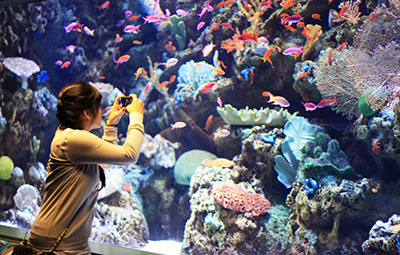Here in the US, the summer travel season is well underway, and popular attractions all across the nation are swarming with tourists. For those of us enamored with marine life, vacation travel often involves a visit to major public aquariums, where we can spend several quality hours figuratively immersed in the underwater realm. (Turns out most facilities get pretty upset if you try to do this literally!)
As a reefkeeper, what I find particularly interesting about visiting public aquariums is not just the enthralling experience they provide while I’m there, but also the information I glean from the exhibits that can be applied to my own systems back home.
Here are just a few examples:
Aquascaping inspiration
The smaller display tanks that are often peripheral to the gazillion-gallon crowd-pleaser tanks in public aquariums can provide excellent insights on how to configure rockwork and other aquascaping features in your home aquarium for optimum aesthetic appeal. Sure, artificial elements (e.g., faux coral inserts, etc.) often stand in for the real thing in these tanks, but it’s easy enough to extrapolate from the design concepts on exhibit.
Which fish species might coexist
Seeing different fish species or conspecific groups “playing nice” in a public aquarium display tank can be helpful in determining whether they’re likely to get along in a home aquarium. However, you do have to take the size of the exhibit into account because both heterospecific and conspecific aggression tends to become more intensified as tank size diminishes.
Which species aren’t on display
You can also learn some important lessons by noting which fish or invertebrate species are conspicuously absent from public aquarium displays. In some cases, this is because the animal in question has a very poor captive survival record or has such specialized feeding/care requirements that it would demand too much of the facility’s resources and the staff’s time.
Obviously, any public aquarium is necessarily limited in the number of species it can exhibit and many different factors influence which ones ultimately get the nod. However, it’s no accident that most of the animals known to fair poorly in home aquariums are seldom displayed in public aquariums. Asking ourselves why certain animals never seem to appear in public aquariums can help inform our own stocking decisions.
How to create a biotope tank
It’s rare for a public aquarium to display random assemblages of species. Rather, their systems are typically designed and stocked to reflect a distinct underwater habitat in a particular geographic region, often very narrow in scope. These exhibits can serves as an inspiration and guide to home aquarists who are interested in designing a biotope tank that replicates a particular underwater niche.
Feeding insights
Public aquariums commonly offer feeding demonstrations and post feeding times on signage and in guide maps and other marketing literature. In some cases, these demos can give attendees some good insights on what to offer the livestock in their home aquariums. Granted, many of these feedings are centered around big animals in big tanks (e.g., shark feeds), but some include smaller systems in their demos. Plus, there are often volunteers on hand who are happy to answer questions on how the staff feeds and cares for the livestock.



